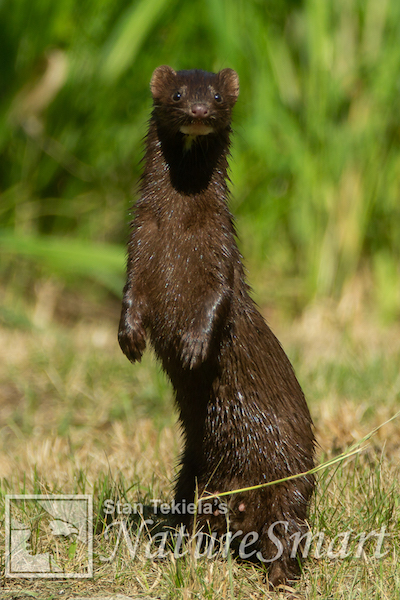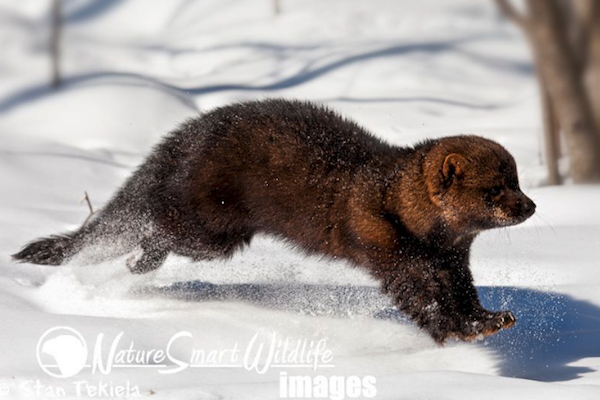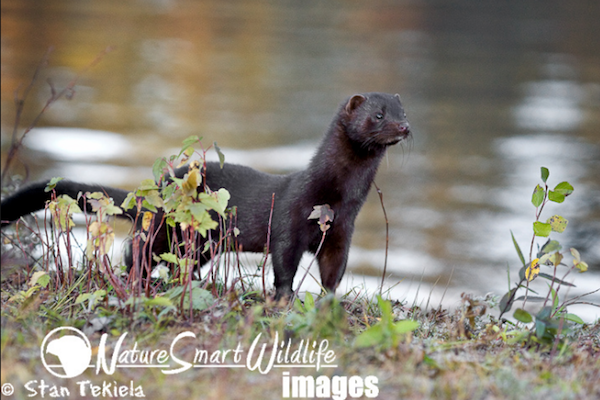Everything Needs to Eat, Including the Mink

Stan Tekiela encounters a mink when checking on his purple martin colony. Find out what happened!
The other day I was working with my purple martin colony. I have 16 gourd nesting boxes that house 16 families, and at this time of year the babies are fledging (leaving the nest for the first time). Earlier in the day, I had picked up one baby martin that was on the ground and put him back into the nest. Having baby martins on the ground for a day or two is perfectly normal. In fact, for many species of birds, it’s normal for the young to spend at least one day on the ground before being strong enough to fly up into a tree. However, I was concerned for my baby martin that a predator might come along, so I put him back in the nest.
Later in the day, two more baby martins were in my lawn. The parents were swooping down to feed them. Their young mouths gaped wide open to accept the insect meals. At this stage of life, the parents are bringing in large insects such as dragonflies. They stuff these huge dragonflies inside the tiny mouths of the baby martins, who eagerly swallow them down. Oftentimes, you can see the wings of a dragonfly hanging out of a baby bird’s mouth.
I have installed a small color video camera (complete with sound) inside one of the martin gourds, and I’ve been monitoring them since the parents first constructed the nest and laid the eggs. At first, the parents bring in tiny insects to feed their blind and naked babies. But as the baby martins grow, they start feeding on larger and larger insects.
Purple martins are the largest species of swallow in North America. At one time in history they used to nest in pairs in tree cavities. Due to decreased nest opportunities, people put up nesting apartments for martins and have totally changed the way they nest. It is now estimated that, west of the Mississippi River, nearly all martins nest in some kind of man-made cavities such as metal or wooden houses or, in my case, plastic gourds. They don’t nest in natural cavities anymore.

It’s a pleasure to host these magnificent birds in my yard, and I really do enjoy seeing and hearing them every day. When the young leave the nest, I feel like an overprotective father. So, sure enough, while I was watching my martins, a mink came running down the shoreline, heading right for the base of my martin houses.
I grabbed my camera to see if I could capture some images of this predator in action. It was fun to watch this mink, which turned out to be a female, run right up to the metal pole that holds up my martin colony and try to climb it. Thank goodness I have a metal predator guard to stop this very thing from happening. So here we were, in the middle of the day, in broad daylight, with a mink running around, following its nose, trying to locate something to eat.
It would point its nose up in the air and sniff around—and then chase off after something it smelled. At one point, it was running through my lawn. I was capturing images of this energetic critter when it started running straight for me. I was sitting down in the grass trying to get a better camera angle when it approached within 10 feet before deciding I might be too large to eat.

It turned and returned to the base of the martin colony. Some of the adult martins gave alarm calls and even swooped down after the mink. Obviously, the martins knew that the mink was a threat to them and their babies.
At one point, the frustrated mink ran over to a large maple tree about 30 feet away and climbed right up the tree just like a squirrel. No hesitation at all, just straight up the tree. No doubt the mink was thinking there might be a way to reach the martin colony and the babies from the tree, but she had no such luck.
The mink scampered right back down the tree and once again over to the base of the martin colonies. I was busy capturing images of this super-fast critter. A couple times, the mink stopped to sniff the air, standing on its hind legs to sniff about. This was when I captured my most favorite images and also when I could see that this was a female mink. No doubt she was feeding young mink back in her den and was actively searching for something to eat. Everything needs to eat, including the predators.
If you enjoyed Stan’s post, you may consider one of his amazing nature books: Majestic Eagles; The Lives of Wolves, Coyotes, and Foxes; or Backyard Birds: Welcomed Guests at our Gardens and Feeders. Young readers will delight in his award-winning children’s books, such as Whose Butt?, Critter Litter, and his latest, Jump, Little Wood Ducks.
You can follow Stan on Facebook and Twitter, or contact him via his web page. Stan’s nationally syndicated NatureSmart Column appears in more than 25 cities spanning 5 states (Minnesota, Wisconsin, Michigan, Illinois, and Pennsylvania) and is circulated to more than 750,000 readers. Stan’s author page on Amazon features some amazing videos! Check them out, and follow him for updates.
For more stories about wildlife and nature, sign up for our newsletter now!
More posts from Stan:
Indigo Bunting—A Familiar Summer Visitor
The Nesting Behaviors of Sandhill Cranes
Big Birds, Baby Birds, Birds Everywhere
Stan Tekiela observes Marsh Wrens
The Magical, Mystical World of Sandhill Cranes


